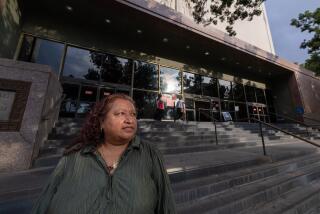The New Road to Splitsville : With differing religions and moving to new jobs, divorce cases are getting complex. Even the ways of finding solutions are changing.
In years gone by, about the only issue that brought families to attorneys’ offices or to courtrooms was the drawing up or disputing of a family will. Today, however, the American family increasingly looks to attorneys, legislatures and the courts to resolve the complexities of contemporary life. Not even recognized as a distinct, board-certified specialty until 1979, family law and its practitioners are proliferating.
One of the newest wrinkles on the pages of family law is a reflection of our mobile culture. Couples leave hometowns, get divorced, and then one wants to return with the children to be near family and friends. Or a divorced spouse gets a superior job offer 2,000 miles away, but the other parent wants the children nearby.
The result is a glut of cases known as “moveaways.” The summer 1995 issue of Family Law News, published by the State Bar of California Family Law Section, called this “Family Law’s $64,000 question.” Court decisions on moveaway cases have gone in all directions. Of the seven cases sent to appeals courts since 1986, four were decided in favor of the parent who wanted to move and three for the noncustodial parent. The few attempts to pass legislation that declares one has a “constitutional right to move” have failed. “These are terribly fact-driven cases,” said Bea Nemlaha, a certified family law attorney in practice in West Los Angeles. Because there are not yet legal standards by which to decide these cases, there is no predictable outcome.
Family law attorneys are now impatiently waiting for a decision from the California Supreme Court. In 1995, the court agreed for the first time to hear a moveaway case, “in re marriage of Burgess.” In this case, both parents worked for the state prison in Tehachapi. The trial court ruled that the mother could transfer to a job at the prison in Lancaster and move there with the couple’s two children. The appellate court reversed the decision. The Supreme Court decided to hear the case to set appropriate standards for similar cases. No hearing date has been scheduled.
If it seems difficult to decide the best interests of children in a moveaway case, imagine being a judge in the divorce of an interfaith couple battling over their children’s religious upbringing.
Interfaith marriages have a higher divorce rate--approaching two-thirds of all such marriages--and parents are increasingly disagreeing about their children’s religious education, said Marshall Zolla, a certified family law attorney in Century City. There may even be conflict between parents of the same religion but differing practices. Zolla handled a case in which an Orthodox Jewish parent insisted that her children keep kosher during visitation with the Reform parent.
“Religious differences between parents in the midst of a divorce are often more resistant to compromise than monetary differences,” Zolla said in a recent speech at the Union of Hebrew Congregations biennial convention in Atlanta.
The response of courts to these very difficult issues have been “all over the place,” Zolla said. The majority of judges have refused to restrict the noncustodial parent from sharing religious beliefs and practices unless it was clear that this exposure would be harmful to the child. “In this country we have separation of church and state,” Zolla said, “so the courts are understandably reluctant to issue orders concerning a child’s religious education.”
*
Social change has not only resulted in different kinds of divorce battles, but has also changed methods of filing. Overcrowded courts and tough economic times have resulted in more couples resorting to private mediation or representing themselves without attorneys.
The use of mediation to resolve family disputes has increased significantly in the last few years. While there are no official statistics, family law attorneys have no doubt the trend is there. Ronald Rosenfeld, a partner in Zimmerman, Rosenfeld, Gersh & Leeds in Beverly Hills, who has been involved with mediation programs since the early 1980s, has seen the change in his own practice. “Four or five years ago I did virtually no mediation work,” he said. “Now it constitutes about 50% of my practice.”
The job of the courts is to determine people’s rights, not necessarily their needs, Rosenfeld said. “In mediation, couples may agree to things that the court might not want to fashion.”
Mediators are often therapists, attorneys or judges, but there are no requirements. “Anyone can hang out a mediator shingle,” Rosenfeld said. He cautions those seeking mediation to investigate the mediator as thoroughly as possible.
In an even more radical change in the way people handle family cases, there is significant activity in Sacramento aimed at simplifying judicial procedures to assist pro per litigants--people who, almost always for economic reasons, have opted to represent themselves. These cases now account for about 75% of family court filings.
The California Judicial Council’s subcommittee on the family court has formed a special task force to assist pro per litigants. Its initial recommendations include simplified legal forms and a family law advisor in each courthouse.
Steps already taken include a simplified form for bringing a contempt action, elimination of an additional filing fee for enforcing a court order, permission for municipal judges to hear cases when the Superior Court is overcrowded, and state authorization for counties to adopt a computerized program to assist the pro per litigant file by computer and have access to computerized calculation of child support. Creation of such a program by counties is not mandated, however.
*
Wading through difficult family changes can be turbulent and exhausting. Some questions have no easy answers.
“In some of these cases, there just isn’t any real justice for anyone involved,” said Susan Coats, chairwoman of the California State Bar Family Law Section. “It doesn’t make sense to deny a remarried person the right to move with her children and new spouse if the spouse is transferred. And it also doesn’t make sense to pull children away from the other parent.”
Regardless of the type of dispute or amount the parents can spend to resolve it, Coats said families can save themselves some grief. “It is imperative that the involved parties take a long, hard look at their motivations. People facing these difficult transitions should make every effort to look at the whole picture and to think long-term,” she said.
“Particularly when young children are involved, [parents] will have contact for a number of years and they are setting the tones for those years. Both parties should be flexible, be willing to give a little and to look for solutions that work for both of them. In my experience, going in to win or to prove a point is impractical, expensive and usually doesn’t create the result they want,” she said.
More to Read
Sign up for Essential California
The most important California stories and recommendations in your inbox every morning.
You may occasionally receive promotional content from the Los Angeles Times.










